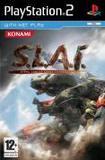You can trust VideoGamer. Our team of gaming experts spend hours testing and reviewing the latest games, to ensure you're reading the most comprehensive guide possible. Rest assured, all imagery and advice is unique and original. Check out how we test and review games here
A few Xbox owners may remember Phantom Crash, a great little mech-combat game from Genki. Released relatively early in the console’s life, the system lacked the user base to make the niche title a success and with Xbox Live in its infancy, it wasn’t one of the early titles to take advantage of it. However, it was praised for its tight gameplay and customisation options, and went on to reach quite a cult status. Some three years later Genki are back with Steel Lancer Arena International (S.L.A.I.), a Konami published follow-up.
The year is 2071, and a new craze called “rumbling” is sweeping across the world. Rumbling, for those that don’t know, is essentially remote control robots battling each other in arenas. Most of the major cities in the world have their own arena, with combatants fighting to reach the top of each city’s ladder, rewarding them with fights against the best from cities across the world. This quest to be the best is actually quite a lengthy one and you’ll even meet a few quirky characters along the way, but things do become a little too familiar towards the end.
Before you start on your quest you have to buy a mech (or SV as they’re called here) and take part in some basic training. Once you’ve finished at battle school you’re ready to start looking for fights at various arenas across the world. To do this you must pick a city server. These servers are your way in to the virtual world of S.L.A.I. (called HAVEN) where the whole backend of the game takes place. You can look for matches, buy upgrades, repair your SV, pick some music to listen to during combat or just wander around. From an aesthetic point of view these servers work well – the attention to detail here is admirable, with a great illusion of a real virtual world – but after a while you’ll be cursing the fact that a more streamlined set of menus wasn’t used.
When you finally get into the combat you have a number of objectives. Your main priority is to take out as many rival SVs and computer controlled drone robots as possible. The more you take out, the more money you earn, but as an SV is taken out, another is released into the arena. You can actually leave the arena at any time by heading to the exit, but the key is to balance your earnings with damage sustained; you don’t want to be earning a lot of money, only for it all to be spent on repairs.
Class matches are more interesting, requiring you to take out all the named opponents in the arena. Doing so will bring in the boss SV who must be defeated in order for you to advance in class. This can get tricky, and attempting to battle the boss SV after a lengthy fight with numerous standard SVs is a recipe for disaster, so the game gives you a little helping hand. You can leave these matches at any time (just as you can in standard matches) and on your return (fully repaired if you can afford it) you only have to defeat the enemies that you hadn’t taken out before.
Controlling these SVs with the Dual Shock 2 is great fun and never cumbersome. Each of the SV’s four weapon units can be fired independently via the four shoulder buttons. You can choose your weapons and make upgrades when inside the servers, with the usual array of machine guns, lasers, rocket launchers and the like all available should you have the money required for the upgrade. The more cautious player will appreciate the stealth that is offered during combat. Most SVs can use a cloak-like camouflage, enabling them to sneak up on an opponent and cause an increased amount of damage from behind. Short hover jumps can also give you an advantage over grounded SVs and can be used to evade enemy fire.
Presentation on the whole is workmanlike, but certainly not ugly. Fights produce plenty of particle effects as weapons are fired left, right and centre, and the SVs are modelled with a pleasing amount of detail. The game’s frame rate does falter now and again, but it’s bearable. Audio is par for the course, with some catchy music and the expected weapon sound effects being heard throughout the arena battles.
Unlike Phantom Crash, S.L.A.I. features online play for up to six players. Strangely, this works in a similar fashion to fights in the single-player story mode, with only four SVs in battle at once. Remaining players sit on the sidelines until a SV is destroyed, opening up a slot in the fight. You can enter online ranking matches with the SV you’ve built up in the single-player game or choose from one of the pre-built SVs and fight in non-ranked matches. There’s also split-screen support for two players, but it’s simply not as entertaining as playing in the larger online matches.
If you’re not too keen on robots fighting in arenas, S.L.A.I. isn’t likely to change your opinion, but anyone with a taste for robot destruction and a fondness of action in general should find plenty to enjoy. While the single-player story mode does become a little tiresome, the online play is lively enough to have some lasting appeal, and at a fairly low RRP it’s certainly worth a gamble.
/https://oimg.videogamer.com/images/9729/slai_10.jpg)






